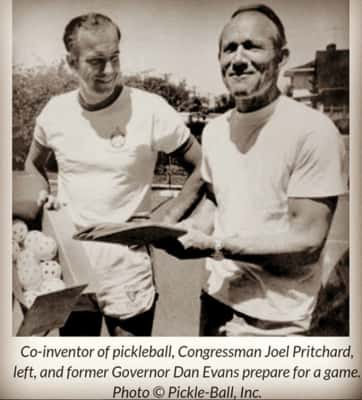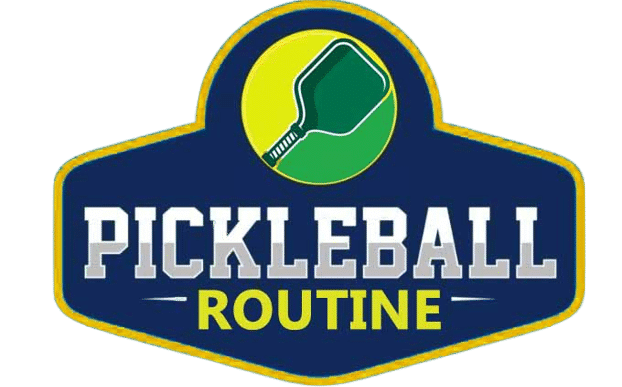Pickleball is a unique paddle sport that combines elements of tennis, badminton, and table tennis. Its intriguing origin dates back to the summer of 1965. Joel Pritchard, a congressman, and his friends Bill Bell and Barney McCallum, sought to create an engaging game to entertain their families on Bainbridge Island, Washington, USA. Using a badminton court, ping-pong paddles, a perforated plastic ball, and a net lowered from its badminton height, they crafted what is now known as Pickleball.

The game was named after the Pritchards’ dog, Pickles, a mischievous Cocker Spaniel who loved to chase and run off with the ball. This playful origin story has contributed to the game’s charm and appeal.
As the game gained popularity, it spread rapidly within the community and beyond. The first official pickleball court was constructed in 1967, and in 1972, the USA Pickleball Association (USAPA) was founded. The USAPA established standard rules, organized tournaments, and promoted the sport nationwide. Today, the USAPA is instrumental in governing pickleball in the United States and fostering its global growth.
Evolution of Pickleball
Pickleball has undergone significant evolution since its inception. Initially played with wooden paddles, the sport has seen advancements in equipment and technology. Modern paddles are now made from lightweight materials like aluminium and composites, enhancing players’ control and power. The perforated plastic balls have also been refined for improved durability and performance.
The sport’s adaptability and low-impact nature make it popular among diverse age groups, from school programs to senior communities. Establishing dedicated pickleball facilities and organising national and international tournaments have further cemented its status as a competitive and recreational favourite.
Combination of Games Making Pickleball
Pickleball is a blend of several sports, combining their best elements to create a unique and engaging game:
Tennis
- Court dimensions, net height, and scoring resemble tennis. The layout is similar to a doubles badminton court, and the net height is the same as in tennis, making it easy for tennis players to transition.
Badminton
- The use of a perforated plastic ball and the double bounce rule are borrowed from badminton. The rule requires each team to let the ball bounce once on their side before returning it, adding an extra layer of strategy.
Table Tennis
- The fast-paced nature and emphasis on quick reflexes are similar to table tennis. The compact court size and proximity to the net mimic table tennis’s close-quarters gameplay.
Racquetball
- The use of paddles and the enclosed court size resemble racquetball, allowing for intense and fast-paced gameplay.
This combination creates a balanced and dynamic sport that appeals to players of all ages and skill levels. Strategies and techniques from these sports enhance the pickleball experience, contributing to its growing popularity.
Basic and Advanced Rules of Pickleball
Understanding pickleball’s rules is essential for maximizing enjoyment and fair play. Here are the fundamental and advanced rules of the game:
Basic Rules
Serving
- Serve diagonally across the court from behind the baseline.
- The serve must be underhand, with contact below the waist.
- The serve must clear the net and land in the diagonal service court. A fault occurs if the serve goes out or hits the net.
Return
- The receiving team must let the ball bounce once before returning it.
- After the bounce, teams can volley or play the ball off a bounce.
Double Bounce Rule
- Each team must let the ball bounce once on each side before volleying.
Non-Volley Zone (Kitchen)
- A 7-foot non-volley zone exists on both sides of the net. Players cannot step into this zone to hit a volley; they must let the ball bounce first.
Scoring
- Pickleball uses a rally scoring system, awarding points on every serve. Games are typically played to 11 points, with a team needing to win by a margin of two points.
Rotation
- In doubles play, the serving team rotates sides after scoring a point, and the receiving team rotates after winning a point.
Check out our guide on Pickleball rules for beginners.
Advanced Rules
Faults
- Stepping into the non-volley zone and hitting a volley.
- Hitting the ball out of bounds.
- Failing to clear the net with a serve or return.
- Letting the ball bounce twice on your side before returning it.
- Touching the net with your body or paddle during play.
Let Serves
- If the serve hits the net and lands in the correct service court, it is considered a “let” serve, and the server gets another opportunity to serve without it being a fault.
Switching Sides
- Players switch sides after each point is scored. The serving team always starts on the right-hand side of the court.
How and Where to Play Pickleball
Pickleball’s accessibility and versatility allow it to be played in various settings:
Community Centers and Recreation Facilities
- Many offer dedicated pickleball courts or designated times for play, often providing necessary equipment. These venues are ideal for beginners and experienced players alike.
Public Parks
- Parks often have designated pickleball courts, attracting players of all ages and skill levels. These courts may be shared with other sports, so checking the schedule is recommended.
Schools and Universities
- Educational institutions often include pickleball in their physical education programs, offering courts for students, faculty, and sometimes the public. This introduces the sport to younger generations.
Private Clubs and Sports Centers
- Private clubs and sports centers may offer exclusive pickleball experiences with leagues, tournaments, and coaching options, providing a more structured environment for play.
Backyard or Home Courts
- Portable nets and court line tapes allow for the creation of pickleball courts at home, providing flexibility and convenience. This option is perfect for casual play with family and friends.
When looking for places to play pickleball, consider court availability, equipment, and specific rules or regulations. Many locations require reservations or have scheduled times for play, so it’s wise to check in advance.
Overall, pickleball’s blend of elements from tennis, badminton, table tennis, and racquetball makes it a delightful and accessible sport, appealing to a broad audience and contributing to its status as one of the fastest-growing sports in recent years. Whether played casually or competitively, pickleball offers everyone an engaging and inclusive experience.
